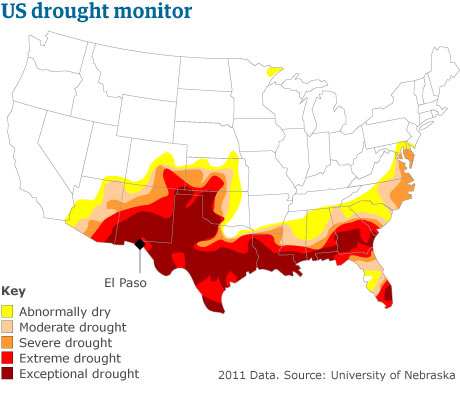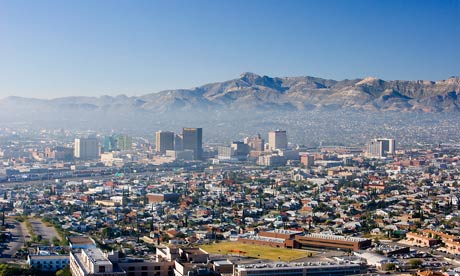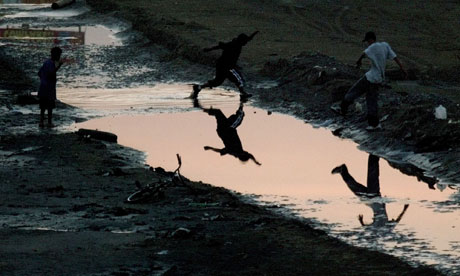When Ed Archuleta first arrived in El Paso to manage the local water authority, the cotton barons and cattle men who run this desert city had a blunt message for him. This is Texas, they told him. We don't do conservation.
It's a good thing Archuleta didn't listen. As a record drought scorched America's south-west this spring, El Paso went 119 days without rain. The Rio Grande, which forms the border with Mexico, shrunk into its banks. An hour's drive out of town, ranchers sold off their cattle so they wouldn't have to watch them die.
Archuleta, in his office overlooking a long seam of strip malls, saw no reason for panic – even though, in his words, the amount of precipitation in the first rain this year was about as much as someone spitting on a water gauge.
"We're going to be fine this summer," he said. "We're basically drought-proof."
The city will be fine next year too, even if it doesn't rain, and even if the Rio Grande stays low. "We can handle drought next year. Theoretically, even if we have no water in the river, even if there wasn't a single drop of water coming from the river, we could make it through the summer," Archuleta said.
Under Archuleta's lead, El Paso has emerged as a model to other cities in the south-west forced to adapt in a hurry to a world running out of water. The prolonged dry spell and declining snowfalls in the mountains due to climate change are forcing cities in Texas and other areas of the south-west into crisis measures.

This year's historic drought has for the first time cajoled cities into water rationing. San Antonio banned all fountains and lawn sprinklers. Galveston asked citizens to avoid filling their swimming pools. Odessa, which could drain its main source of ground water by the end of 2012, is thinking of building a reclamation plant.
It's been a shock awakening. According to some projections, 900 communities in the south-west could go dry by the middle of the century if there is a serious drought. But Texas is a conservative state, and there is reluctance to talk about the extreme events caused by climate change. It is also the only western state that does not have a central authority to manage ground water. In the lone star state, it's every one for themselves.
"It is basically a pirate's approach," said John Matthews, director of fresh water and climate change at Conservation International. "The right of capture is the legal framework. If you're able to get it, then it's yours. If you're on a river and draw all the water, then it's just tough luck for the people downstream. If you deplete an aquifer on your land and that aquifer serves a much larger area, then it's just tough luck to the other people."
But El Paso, isolated from the rest of Texas on the border with Mexico and more than 500 miles away from the state capital, Austin, has always operated a little bit outside the norm.
It was already confronting its own water emergency when Archuleta came to town 22 years ago. The Chihuahua desert city had grown rapidly over the years, because of the Fort Bliss military base and migration from Mexico.
The city had two sources of water: the Rio Grande, whose waters are shared with New Mexico and Mexico, and two underground aquifers, which contain both brackish and fresh water.
By the time Archuleta took over El Paso Water Utilities (EPWU), the city was dangerously close to exhausting its ground water. In some areas of the Hueco aquifer, water levels had dropped 70 feet or more. Fresh water was running out, and the share of brackish water was rising.
 A map showing El Paso's position on the Rio Grande
A map showing El Paso's position on the Rio Grande
Meanwhile, there were increasing demands on the Rio Grande from the expanding populations of El Paso, as well as Las Cruces in New Mexico and Ciudad Juárez across the border.
Archuleta saw two choices: use less water or let the city die. So the water authority encouraged a series of conservation measures. One of the biggest targets was reducing the water sprayed on gardens, which accounts for nearly a third of household use.
Over the years, residents were paid $1 a foot of sod to tear out their lawns and replace them with less thirsty varieties of grass, or sand. Neighbourhood associations promoted xeriscaping, replacing thirsty imported plants like palm trees with varieties that don't need much water.
Homeowners were offered rebates to install more efficient air-conditioning systems, which offered big savings over popular swamp coolers, and to swap washing machines and toilets for new low-water models. A few years ago, the authority ran a programme handing out free low-water showerheads from school parking lots.
At the same time, it invested heavily in treatment plants to recycle wastewater for use on golf courses, cemeteries, school and military parade grounds. It sold the recycled water to industries as coolant, and to local farmers. The city now recycles and sells about 12% of wastewater.
The authority also expanded its supply, building a desalination plant – the biggest inland facility in the US – to treat the brackish water from the aquifer. The new facility pumps the fresh water back into the aquifer to replenish.
Next door, a water museum teaches children about the importance of "purple water" – named after the purple pipes that carry the recycled wastewater – and how to save water at home by watering their gardens less, or turning off the taps when they're brushing their teeth.
It does not immediately look as if El Paso is doing without. The mansions that cling to the hills west of town still have swimming pools and lushly manicured shrubs – but no lawns. For years, residents have only been allowed to water their gardens only on alternate days, and only in the early morning or evening hours in the summer.
 Dry state ... a view over El Paso, Texas. Photograph: Jose Fuste Raga/Corbis
Dry state ... a view over El Paso, Texas. Photograph: Jose Fuste Raga/Corbis
By now, such measures are a way of life. Per capita water use for the city of El Paso has dropped in the last 20 years from 167 gallons of water a day (754 litres) to 111 gallons, according to the official figures. That's barely a quarter of the average daily use in the US, a global water-hog that uses nearly 500 gallons a day per capita (or nearly 600 US gallons). It's also below the more moderate levels in the UK.
Elsewhere in Texas, Dallas rinses 200 gallons per capita a day with ambitions of only modest reductions over the next decade, according to a report last year.
Archuleta now believes that El Paso has reached its limit for conservation. Future plans even allow for water use to creep up again – an idea that angers environmental groups.
"They have some conservation programmes, sure, but they are still encouraging El Paso to grow at an exponential rate, which is a mistake," said Bill Addington, a rancher and member of the local branch of the Sierra Club. "More people equals more water, no matter how you look at it. El Paso shouldn't be like an aggressive cancer – just growth and more growth."
The city's burgeoning thirst for water means less for everyone else: the farmers who rely on the Rio Grande to irrigate their alfalfa fields, and the ranchers. On George Parada's land, which runs along the border wall with Mexico, a tributary of the Rio Grande that is ordinarily hip-high has dropped to ankle-deep.
Unless the authorities release more water from the river, there will not be enough grass for grazing. His herd is having to feed primarily on the pods that hang from mesquite trees. The cows are already growing thin. "Either I've got to sell everything and get them out of here or they are going to die," he said.
But Archuleta does not see how the people of El Paso can do with any less. According to EPWU's manager, conservation efforts have gone as far as they can – which brings him to a far more controversial phase of his water plan: securing future supplies.
In recent years, the city has bought up 100,000 acres of land in outlying areas, purchasing the rights to the water that flows underneath. He also foresees the day when it will have to invest in water pipelines, pumping water in from much further away. "That is our insurance policy," Archuleta said.
He no longer fears El Paso will run out of water. With proper management, underground aquifers will still have 75% of their water in 100 years. "We decided 20 years ago we had to be prepared for just about everything," Archuleta said. "When you live out in the desert like we do, it doesn't hurt to have extra capacity."
• The following correction was printed in the Guardian's Corrections and clarifications column, Tuesday 12 July 2011. In an article on the management of water in El Paso, Texas, conversions in the editing process from US to imperial gallons resulted in confusion about figures given. The piece, as published, said: "Per capita water use for the city of El Paso has dropped in the last 20 years from 167 gallons of water a day (754 litres) to 111 gallons. That's barely a quarter of the average daily use in the US, a global water-hog that uses nearly 500 gallons a day per capita." These per capita (water use for the entire town, industry, agriculture and so forth) figures were in imperial gallons. Here are the US gallon figures from the story as originally filed: El Paso per capita water use dropped from 201 gallons a day to 133 gallons, and the US uses nearly 600 gallons a day per capita.

